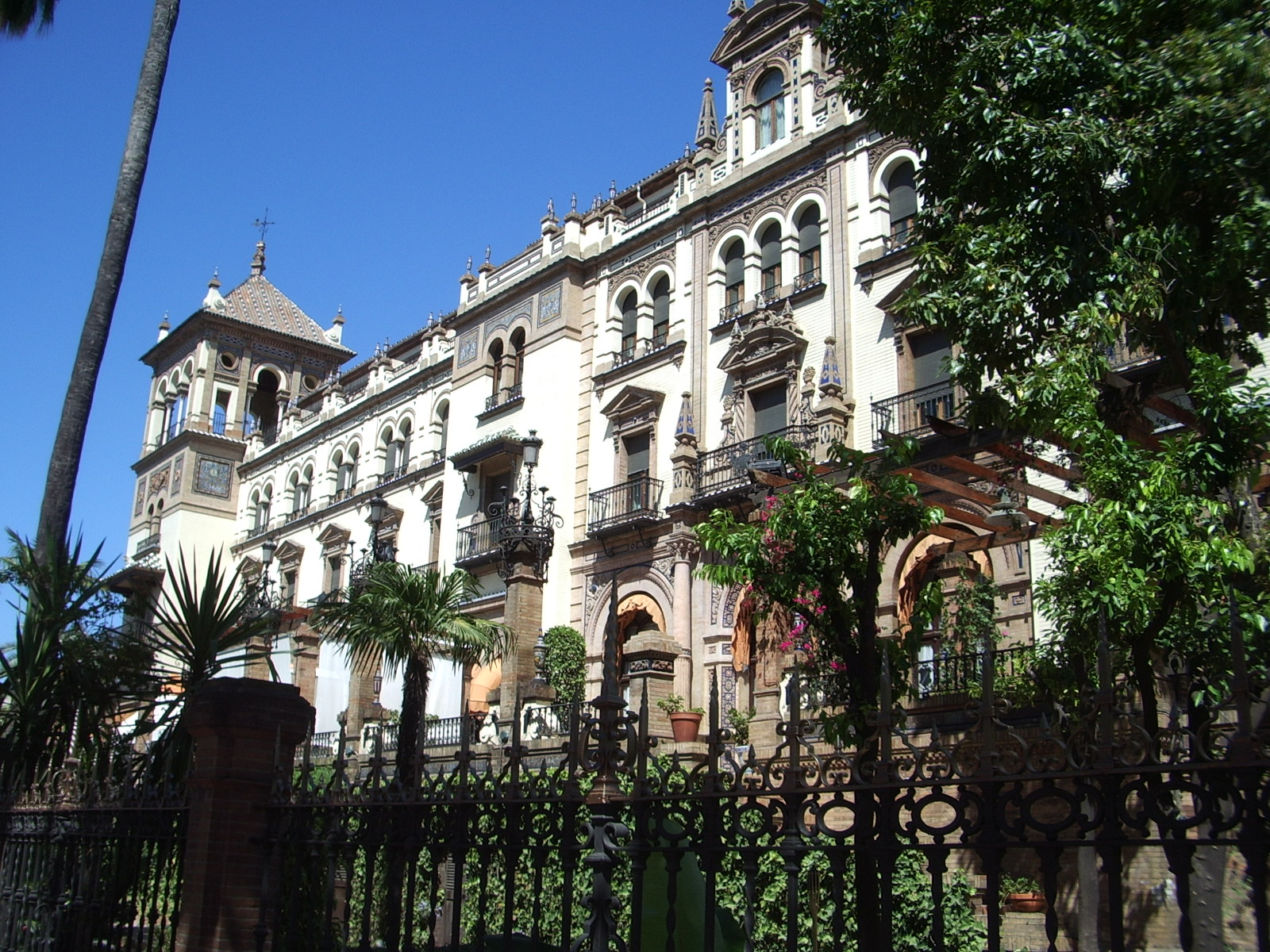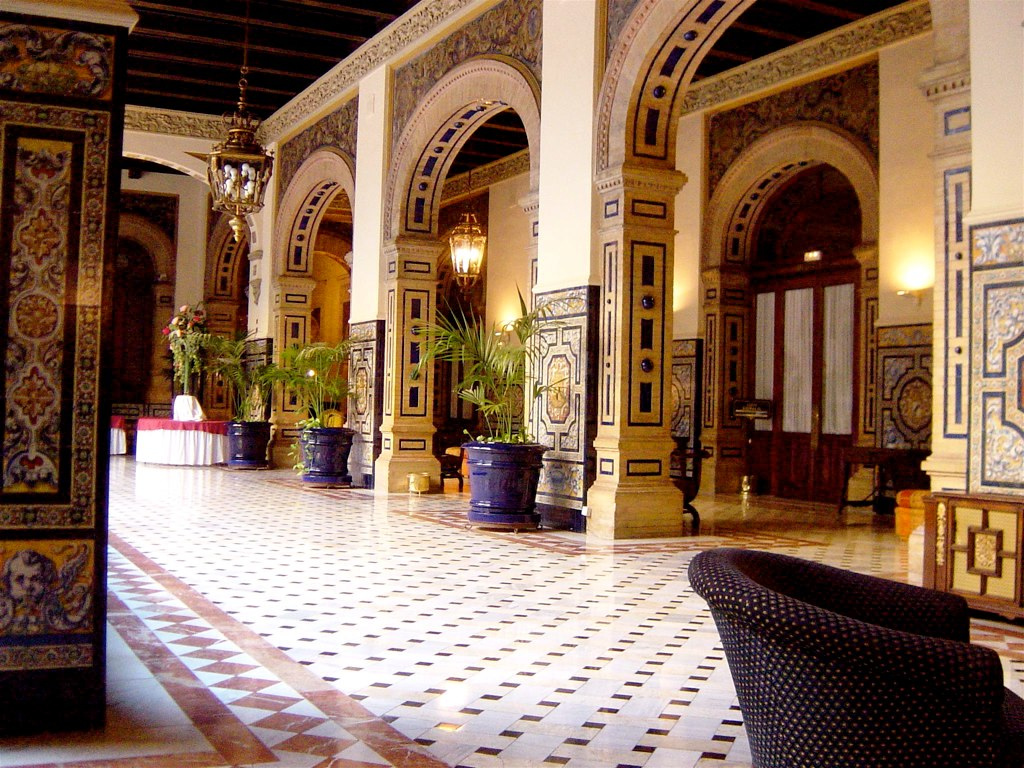Hotel Alfonso XIII on:
[Wikipedia]
[Google]
[Amazon]
 Hotel Alfonso XIII is a historic hotel in
Hotel Alfonso XIII is a historic hotel in
 The hotel has six banqueting halls, the largest of which accommodates up to 650 people. The Royal Hall, the largest and most ornate, was originally the hotel's main dining room. It is accessed through a
The hotel has six banqueting halls, the largest of which accommodates up to 650 people. The Royal Hall, the largest and most ornate, was originally the hotel's main dining room. It is accessed through a
Official site
{{DEFAULTSORT:Alfonso XIII Hotels in Andalusia Hotel Alfonso XIII Hotels established in 1929 Hotel buildings completed in 1928 1928 establishments in Spain Neo-Mudéjar architecture in Spain
 Hotel Alfonso XIII is a historic hotel in
Hotel Alfonso XIII is a historic hotel in Seville
Seville (; es, Sevilla, ) is the capital and largest city of the Spanish autonomous community of Andalusia and the province of Seville. It is situated on the lower reaches of the River Guadalquivir, in the southwest of the Iberian Peninsula ...
, Spain
, image_flag = Bandera de España.svg
, image_coat = Escudo de España (mazonado).svg
, national_motto = ''Plus ultra'' (Latin)(English: "Further Beyond")
, national_anthem = (English: "Royal March")
, i ...
, located on Calle San Fernando, next to the University of Seville
The University of Seville (''Universidad de Sevilla'') is a university in Seville, Spain. Founded under the name of ''Colegio Santa María de Jesús'' in 1505, it has a present student body of over 69.200, and is one of the top-ranked universi ...
. Designed by the architect José Espiau y Muñoz, it was built between 1916 and 1928 especially for the Ibero-American Exposition of 1929. It officially opened on April 28, 1929, with a sumptuous banquet attended by King Alfonso XIII
Alfonso XIII (17 May 1886 – 28 February 1941), also known as El Africano or the African, was King of Spain from 17 May 1886 to 14 April 1931, when the Second Spanish Republic was proclaimed. He was a monarch from birth as his father, Alf ...
and Queen Victoria Eugenie of Battenberg
Victoria Eugenie Julia Ena of Battenberg (24 October 1887 – 15 April 1969) was Queen of Spain as the wife of King Alfonso XIII from their marriage on 31 May 1906 until 14 April 1931, when the Spanish Second Republic was proclaimed. A Hessi ...
. The hotel is owned by the City of Seville and managed by The Luxury Collection division of Marriott International.
History
Designed by architect José Espiau y Muñoz, the hotel was built between 1916 and 1928, and officially inaugurated on 28 April 1929, with a celebration preceded by King Alfonso XIII and Queen Victoria Eugenia. The reason of the celebration was the wedding of Infanta Isabel with count Juan Zamoyski. The hotel was a winning project chosen among others after a contest was held under the direction of renowned architect Aníbal González. Espiau reached the award, and built a hotel destined to be the hotel of the Iberoamerican Exposition of 1929. During the Second Republic, its name was changed to Hotel Andalucía Palace. It later recovered its original name, conserved to date.Architecture
The building is in theNeo-Mudéjar
Neo-Mudéjar is a type of Moorish Revival architecture practised in the Iberian Peninsula and to a far lesser extent in Ibero-America. This architectural movement emerged as a revival of Mudéjar style. It was an architectural trend of the late ...
style. This style is historicist
Historicism is an approach to explaining the existence of phenomena, especially social and cultural practices (including ideas and beliefs), by studying their history, that is, by studying the process by which they came about. The term is widely u ...
and, in this case also has an aspect of Andalusia
Andalusia (, ; es, Andalucía ) is the southernmost autonomous community in Peninsular Spain. It is the most populous and the second-largest autonomous community in the country. It is officially recognised as a "historical nationality". The t ...
n regionalism. Initially designed in 1916, it blends in with the overall aesthetics of the buildings planned for the Ibero-American Exposition of 1929. Its façade and its overall construction display a significant wealth of decorative elements and details, built from materials that could well be considered as frugal or simple: mostly brick, plaster, wood and ceramics.
The interior puts forth a display of wealth and status: arches and columns, decorated with elaborate coffered hanging lamps and fine carpets from the Royal Tapestry Factory. Ornamented ceramic tiles (''azulejo
''Azulejo'' (, ; from the Arabic ''al- zillīj'', ) is a form of Spanish and Portuguese painted tin-glazed ceramic tilework. ''Azulejos'' are found on the interior and exterior of churches, palaces, ordinary houses, schools, and nowadays, r ...
s'') decorate walls, ceilings and all manner of structures. The luxurious rooms were designed to accommodate kings, presidents, celebrities and other guests of the Ibero-American Exposition of 1929. The floors are marble and wood.
Banqueting halls
 The hotel has six banqueting halls, the largest of which accommodates up to 650 people. The Royal Hall, the largest and most ornate, was originally the hotel's main dining room. It is accessed through a
The hotel has six banqueting halls, the largest of which accommodates up to 650 people. The Royal Hall, the largest and most ornate, was originally the hotel's main dining room. It is accessed through a wrought iron
Wrought iron is an iron alloy with a very low carbon content (less than 0.08%) in contrast to that of cast iron (2.1% to 4%). It is a semi-fused mass of iron with fibrous slag inclusions (up to 2% by weight), which give it a wood-like "grain" ...
gate similar to those that enclose the choirs of several Andalusian cathedrals. Inside, eleven bronze chandeliers hung with Bohemian crystal and plated in gold descend from a palatial coffered ceiling. Large arched doorways inlaid with mahogany and inlaid tiles (''azulejos'') lead to a terrace over the garden of the hotel. Other neoclassical banqueting halls or salons—Andalusia, Híspalis and Cartuja—feature arched doors and windows with frames of golden stucco, more Bohemian glass chandeliers and marble floors.
Inner courtyard
As is typical of the region, the hotel has an inner courtyard or ''patio
A patio (, from es, patio ; "courtyard", "forecourt", "yard", "little garden") is an outdoor space generally used for dining or recreation that adjoins a structure and is typically paved. In Australia the term is expanded to include roofed str ...
''. The original design inspired was for a courtyard modeled on that of Seville's baroque Hospital de los Venerables, but was redesigned at the express request of Alfonso XIII, who disapproved of the original plan.
Rooms
The building has a total of 147 guest rooms, each unique: * 19 single rooms. * 55 luxury double rooms. * 55 larger "deluxe" rooms, with lamps ofVenetian glass
Venetian glass () is glassware made in Venice, typically on the island of Murano near the city. Traditionally it is made with a soda–lime "metal" and is typically elaborately decorated, with various "hot" glass-forming techniques, as well as ...
from Murano, and wooden ceilings. There are three categories of decoration: Castillian, Baroque and Mozarabic
Mozarabic, also called Andalusi Romance, refers to the medieval Romance varieties spoken in the Iberian Peninsula in territories controlled by the Islamic Emirate of Córdoba and its successors. They were the common tongue for the majority of ...
.
* 1 Royal Suite, used by royal families who are visiting Seville.
Other
The building also includes several bars, the San Fernando restaurant, a pool, a gym, a massage center, and several terraces and gardens.Illustrious guests
Diplomats representing the Ibero-American countries, as well as King Alfonso and his wife, attended the 1929 exhibition. However, no foreign presidents attended, except the Norwegian President Johan Ludwig Mowinekel, who came for a private visit, and the Portuguese President Fragoso. The hotel housed personalities during the 1992 show, such as the Prince Charles and Diana of Wales. It is common for celebrities visiting the city to stay there, such as Brad Pitt,Angelina Jolie
Angelina Jolie (; born Angelina Jolie Voight; June 4, 1975) is an American actress, filmmaker, humanitarian and former Special Envoy to the UN High Commissioner for Refugees. The recipient of numerous accolades, including an Academy Award ...
, Tom Cruise
Thomas Cruise Mapother IV (born July 3, 1962), known professionally as Tom Cruise, is an American actor and producer. One of the world's highest-paid actors, he has received various accolades, including an Honorary Palme d'Or and three Go ...
, Cameron Díaz, Madonna and Bruce Springsteen.
See also
* List of hotels in SpainReferences
External links
Official site
{{DEFAULTSORT:Alfonso XIII Hotels in Andalusia Hotel Alfonso XIII Hotels established in 1929 Hotel buildings completed in 1928 1928 establishments in Spain Neo-Mudéjar architecture in Spain